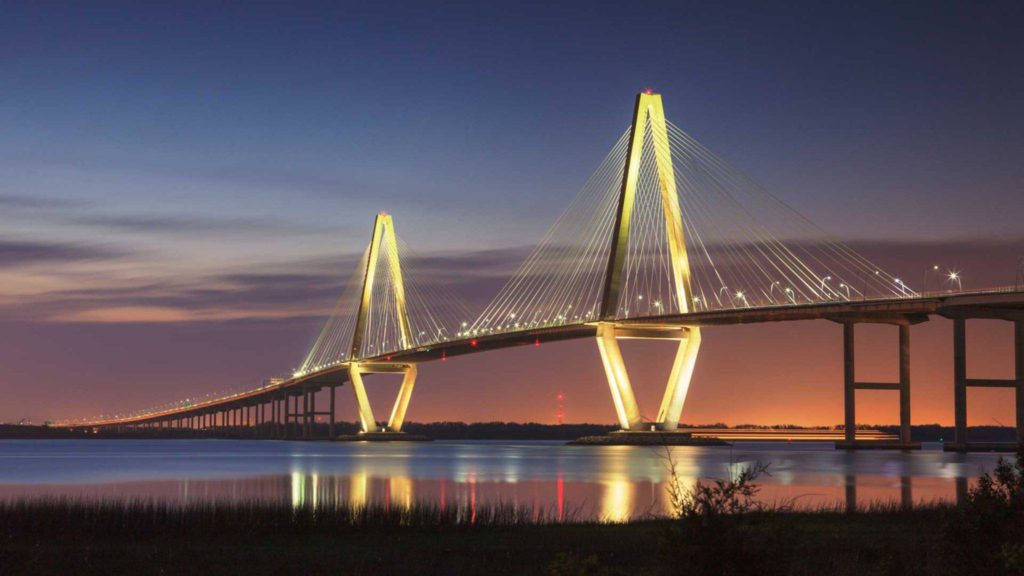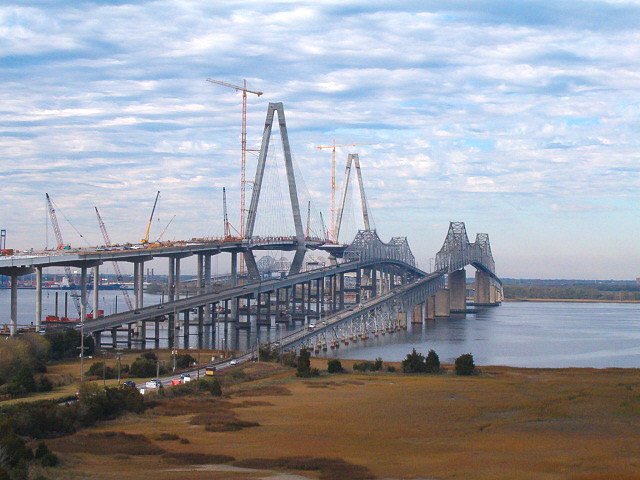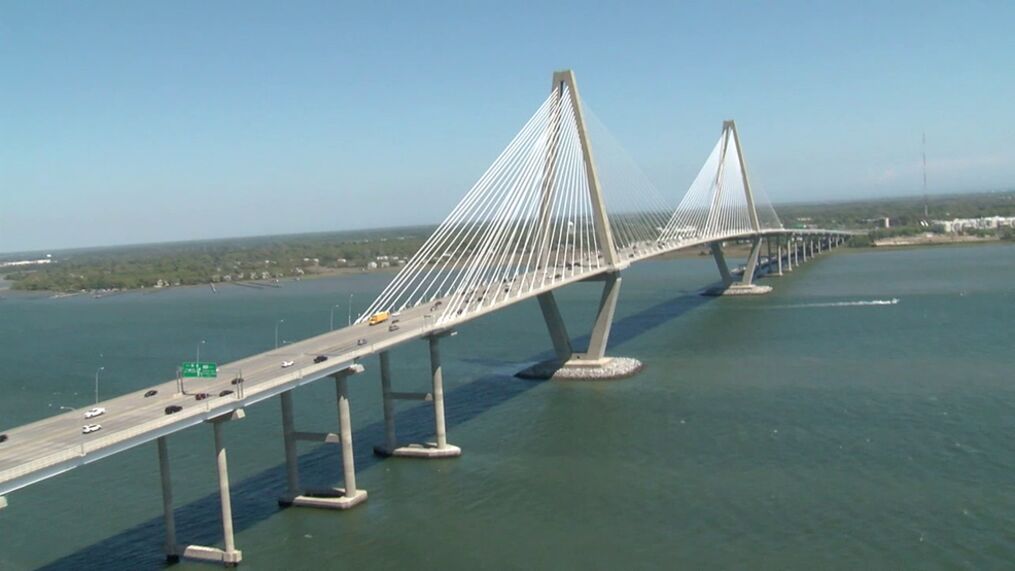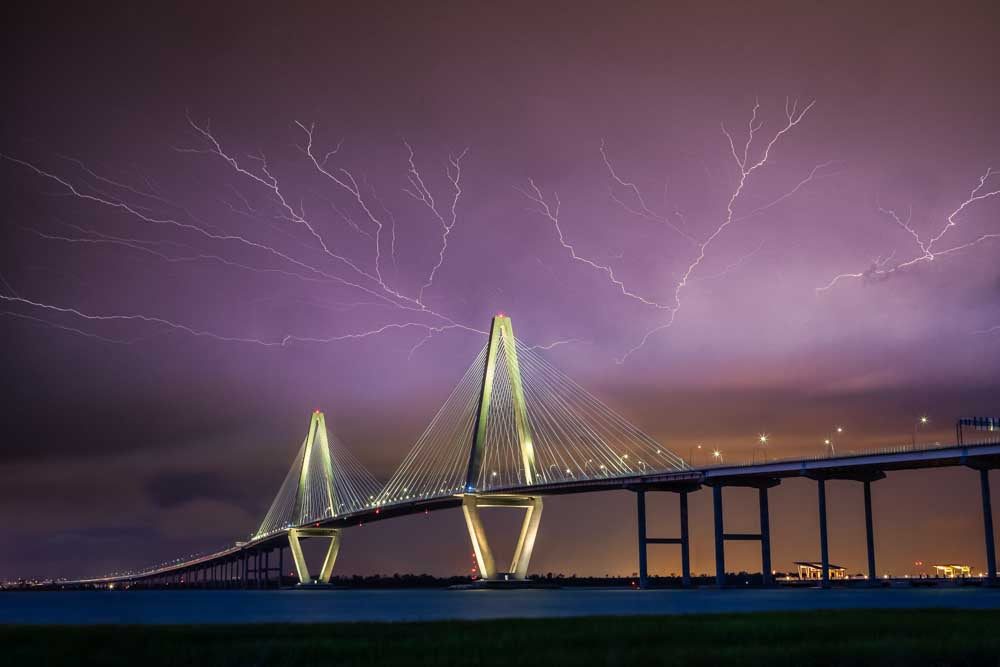The History of the Arthur Ravenel Jr. Bridge

When looking at the skyline of Charleston, SC, you’ll notice lots of churches, colorful old houses, and just a few tall buildings. By far the tallest structure of them all, and perhaps the most iconic, is the Arthur Ravenel Jr. Bridge, located at the northeast end of downtown.
Completed in 2005, the Arthur Ravenel Jr. Bridge, or Cooper River Bridge, as the locals often call it, was built to replace two old and rickety bridges connecting downtown Charleston to Mt. Pleasant via Highway 17.
These bridges were the John P. Grace Memorial Bridge, opened in 1929, and the Silas N. Pearman Bridge, opened in 1966. They were in notoriously poor condition and many considered it scary to drive over them, noting that you could feel the bridge swaying while you drove across in the extremely narrow lanes.
Replacing the Cooper River Bridges had long been a discussion in South Carolina politics, as the Grace Memorial Bridge had been declared structurally obsolete as early as 1979. However, the state had always claimed that the idea of replacing the bridges was too expensive.

It wasn’t until 1995, when a bridge inspector scored the Grace Memorial Bridge a 4 out of 100 for safety, and was rumored to have said that he would not risk driving his own family over that bridge.
Additionally, the city had been growing at a rapid pace and the old bridges were no longer able to handle the volume of traffic driving over them on a daily basis. The height and width of the main span beneath the bridges was also inadequate for the increasing number and size of commercial ship traffic passing underneath of them.
All of this prompted the former South Carolina senator Arthur Ravenel Jr. to campaign for funding the new bridges. His campaign was a success, and the bridge was subsequently voted to be named after him, which was a subject of some controversy back in 1999.
The Ravenel name remains controversial to this day, as the son of Arthur Ravenel Jr., Thomas Ravenel has gotten himself into quite a bit of trouble over the years. Thomas was formerly the South Carolina state treasurer but ended up spending 10 months in prison on federal cocaine charges in 2008. Later he was on the cast of Bravo’s Southern Charm before pleading guilty to assault and battery charges in 2019.
Regardless of its controversial name, the Ravenel Bridge is an architectural feat and a vast improvement on its predecessors. Construction began in 2001 and the bridge was completed in 2005, followed by much celebration as well as the closing and demolition of the old bridges, a televised event.
Specifics of the Ravenel Bridge

The Arthur Ravenel Jr. Bridge was completed and open one full year ahead of its projected opening of 2006, and was also brought in $100 million under budget. At 2.5 miles long, it is the third longest cable-stayed bridge in the Western Hemisphere. Its towers stand a full 575 feet high, with elevators inside of each one for maintenance and inspection.
Design and build credit for the bridge goes to the engineering firm Parsons Brinckerhoff, whom were faced with several challenges with this project.
First, the bridge had to be tall enough to accommodate commercial traffic for the Port of Charleston, which is one of the busiest ports on the east coast.
It also had to be strong enough to withstand an earthquake that’s at least as strong as Charleston’s 1886 earthquake, which was a 7.3 on the Richter Scale, as well as the 150+ mph winds brought on by storms like 1989’s Hurricane Hugo.

An additional challenge was presented by the inherent geography of the Charleston region, which is lovingly known as the Lowcountry. The land is marshy and the foundation is mud, and naturally prone to lots of flooding. This required the drilling of specially-designed 10 ft wide shafts up to 230 feet below the waterline.
With shipping in mind, the towers supporting the main span of the bridge are protected by rock islands that form a pyramid shape all the way to the bottom. This way, if a ship or barge were to veer off course, it would be stopped by the rocks before damaging the bridge. The main span of the bridge is 1030 feet wide and 250 feet high, allowing plenty of room for shipping traffic to pass underneath.
The Arthur Ravenel Jr. Bridge has 8 driving lanes and one full lane on the south side for biking and pedestrians. It was designed to support 100,000 cars worth of traffic per day, which had been estimated at the time to happen around 2030. As of 2021, the bridge saw an average daily traffic count of over 97,000.
See below an old news story detailing the construction process of the Ravenel Bridge.
Walking, running, and biking the bridge is a favorite activity for residents of Charleston and tourists alike. Reaching the top of the center span offers a bird’s eye view of Charleston Harbor and the city skyline. The bridge is also the centerpiece of the annual Cooper River Bridge Run, the 10-K run which has been taking place since 1978 on the old bridges.
Charleston would not be what it is today without the Arthur Ravenel Jr. Bridge. Its presence in the skyline and in the daily function of the lives of Charleston’s residents is appreciated by all. This is clearly seen in many postcard shots of the city, as well as on the Instagram feeds of people in Charleston on a daily basis.